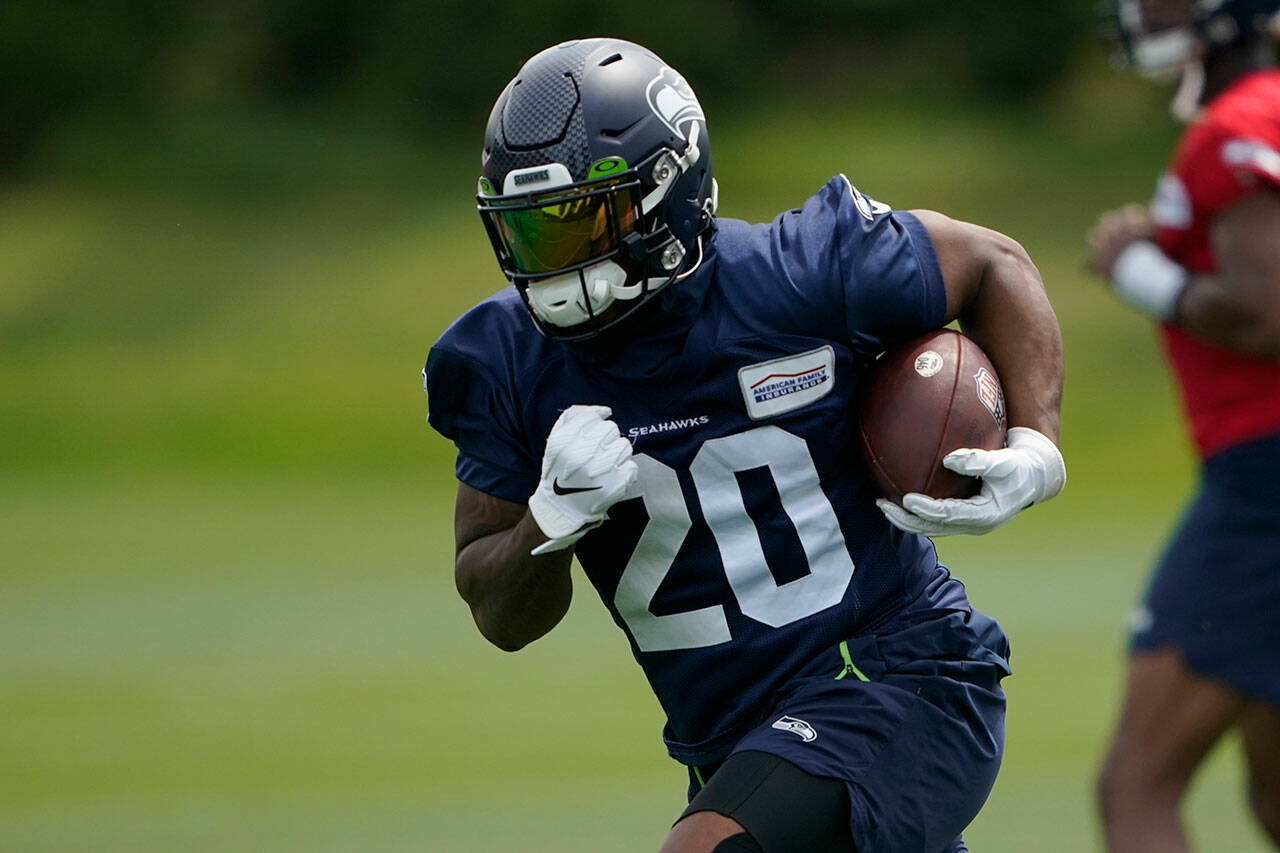By Bob Condotta / The Seattle Times
RENTON — The March 8 trade of Russell Wilson to Denver has fueled almost constant speculation that the Seahawks will do something to add to their quarterback position.
But here we are, three months later and with the Seahawks set to head into their summer break this week after three final OTAs (organized team activities), and Seattle’s QB depth chart reads the same — Geno Smith, Drew Lock and Jacob Eason.
Certainly, that might change should Baker Mayfield, or maybe even Jimmy Garoppolo, get released and become available for not a whole lot.
But getting this deep into the offseason with the three QBs on hand reinforces the idea that for 2022, the Seahawks think they might just have a formula they can win with on offense.
And what exactly is that?
“First off, I think you got to have a great run game in this offense,” Lock said last week. “That’s what this offensive style of ball is made on. And when you have a great run game, the linebackers, everyone’s ready for the run. And we have play-action pass in this offense. The play-action pass in this … offense is my favorite part about it. And I think that’s what I do really, really well. Especially when you add Tyler [Lockett] and DK [Metcalf] into the mix, it’s an exciting thing to look at. It’s an exciting thing to see on tape from film last year.”
None of that is a surprise to Pete Carroll watchers. Carroll has long espoused the importance of a strong running game and its impact in setting up a successful passing attack, even if many analytic studies in recent years have questioned if there is a correlation.
“[Over the] last three years we find no connection, relationship or correlation between teams who run the ball well and teams who win the most games,” NFL analyst Warren Sharp wrote in 2018. “Running is used to complement passing, but passing is what determines wins and losses in today’s NFL.”
So did it matter to Wilson’s and the Seahawks’ success during the past 10 years whether the team had a strong running game?
Those who believe it didn’t could point to the 2017 season, when Wilson led the NFL with 34 touchdown passes in a season Seattle had the worst running game of the Carroll era other than his first season in 2010.
Carroll, though, undoubtedly saw his belief reinforced in the final six games of last season, when Seattle rushed for 146 or more yards five times. Seattle scored 24 or more points in each of those five games, winning four.
The question, of course, is whether the running game can be as effective in setting up the rest of the offense with quarterbacks other than Wilson. Carroll is banking that it can.
Spurring the rushing attack was the emergence of fourth-year running back Rashaad Penny, who gained 671 yards over the final five games of the season, and 135 or more four times.
That stretch almost matched Penny’s rushing total of his injury-plagued career to that point — he had 823 yards combined in his first three years, when he missed 18 games.
Can Penny do it again?
It’s a question that resonates even more with the news last week that running back Chris Carson was not cleared to participate in last week’s mandatory minicamp while still recovering from neck surgery in December. He faces another exam this month that could determine his football future.
Carroll’s comments about Carson last week were the most stark he’d made, indicating that the playing future of Carson is in doubt. But it’s hardly a surprise to the Seahawks, who have understood since it was a possibility.
That’s why the Seahawks made re-signing Penny a priority, agreeing to a one-year deal in March worth up to $5.75 million with $5.070 million guaranteed.
That deal makes Penny the NFL’s 14th-highest-paid running back this year, according to OvertheCap.com, and 13th-highest salary-cap hit.
The next month, the Seahawks drafted Ken Walker III out of Michigan State with the 41st overall pick, with it becoming clear they would also have considered Breece Hall — who was the first running back taken at No. 36 by the Jets — had he been available and Walker already selected.
Many national draft analysts questioned Seattle taking Walker there, given the presence of Penny and Carson on the roster. But the pick was a huge hedge on Carson’s availability, as well as a way to replenish the position for the future with the contracts of Penny and Carson running out after the 2022 season.
But if Carson can’t play in 2022 — or ever again — this season might turn into a referendum on whether Seattle can truly depend on Penny to be a reliable every-game running back.
The good news for Seattle is that aside from missing one OTA open to the media due to a tight hamstring, Penny was otherwise working full go throughout.
When he spoke to the media last week, before Carroll’s comments about Carson, Penny said he doesn’t feel like he’s arrived, noting that at times he’s his harshest critic.
“I’ve still got a chip on my shoulders,” Penny said. “I’ve still got to play. I still have to prove myself wrong. And I’ve still got a lot to go. I’m not settling down yet.”
And if you believe running backs matter — and that a strong running game is needed to set up the pass, as Carroll does — then Penny’s ability to prove himself wrong once more this year might suddenly be more important than ever.
Talk to us
> Give us your news tips.
> Send us a letter to the editor.
> More Herald contact information.

























